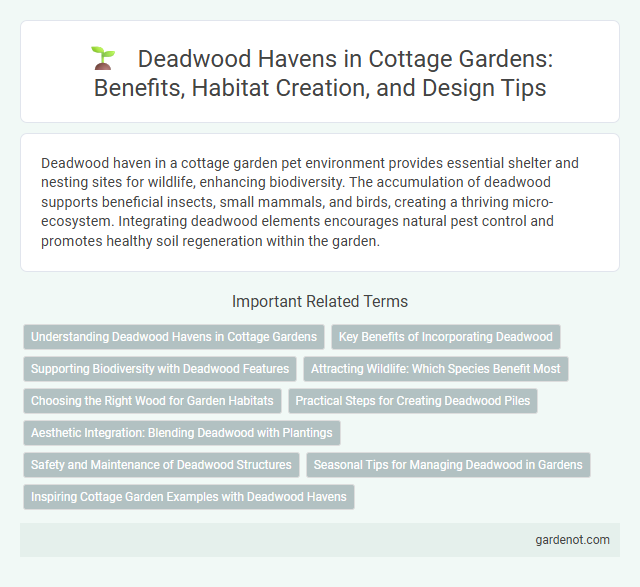Deadwood haven in a cottage garden pet environment provides essential shelter and nesting sites for wildlife, enhancing biodiversity. The accumulation of deadwood supports beneficial insects, small mammals, and birds, creating a thriving micro-ecosystem. Integrating deadwood elements encourages natural pest control and promotes healthy soil regeneration within the garden.
Understanding Deadwood Havens in Cottage Gardens
Deadwood havens in cottage gardens provide essential habitats for beneficial insects and contribute to biodiversity by offering shelter and food sources year-round. These areas, composed of old branches and decaying wood, enhance soil health through natural decomposition processes, promoting nutrient cycling. Incorporating deadwood havens supports ecological balance and encourages pollination, making cottage gardens more resilient and thriving ecosystems.
Key Benefits of Incorporating Deadwood
Incorporating deadwood into a cottage garden enhances biodiversity by providing essential habitats for insects, birds, and fungi, promoting a healthier ecosystem. Deadwood also contributes to soil fertility as it decomposes, enriching the garden with organic matter and nutrients. Embracing deadwood helps maintain natural garden aesthetics and supports sustainable gardening practices.
Supporting Biodiversity with Deadwood Features
Deadwood features in a cottage garden create essential habitats that support a wide range of biodiversity, including insects, fungi, and birds. Incorporating logs, branches, and stumps encourages natural decomposition processes that enrich soil health and provide shelter for beneficial wildlife. This practice enhances ecosystem balance and promotes pollination and pest control within the garden environment.
Attracting Wildlife: Which Species Benefit Most
Deadwood havens in cottage gardens attract beneficial wildlife, supporting species such as beetles, spiders, and woodlice that thrive in decaying wood habitats. Birds like woodpeckers and wrens benefit from the shelter and food sources these refuges provide, enhancing biodiversity. Fungi and invertebrates within deadwood also play crucial roles in nutrient cycling and soil health, sustaining the garden ecosystem.
Choosing the Right Wood for Garden Habitats
Selecting the right wood for a Deadwood haven in a cottage garden involves prioritizing natural, untreated hardwoods like oak, ash, or hawthorn that resist decay and provide ideal habitats for insects and fungi. Avoiding chemically treated or softwoods ensures a safe environment for beneficial wildlife while promoting biodiversity. Incorporating varied wood sizes and states of decay enhances shelter options and supports a robust ecosystem within the garden habitat.
Practical Steps for Creating Deadwood Piles
Deadwood piles in cottage gardens provide essential habitats for beneficial insects and wildlife, enhancing biodiversity. To create effective deadwood havens, collect a variety of branches, twigs, and logs from different tree species and arrange them in layered, loosely stacked piles to allow air circulation and ease of access for insects. Position these piles in shaded, undisturbed corners of the garden to mimic natural forest conditions, promoting decomposition and shelter throughout the seasons.
Aesthetic Integration: Blending Deadwood with Plantings
Deadwood in cottage gardens enhances aesthetic integration by providing natural texture and rustic charm that complements lush, informal plantings. Strategic placement among perennials and climbers helps create visual harmony, emphasizing organic shapes and aged character. This blend supports biodiversity by offering habitat and fostering a seamless transition between living plants and woody elements.
Safety and Maintenance of Deadwood Structures
Deadwood in cottage gardens poses safety risks such as structural instability and potential pest infestations, necessitating regular inspection and secure removal of hazardous branches. Proper maintenance involves pruning deadwood to enhance plant health and prevent decay, which supports overall garden safety. Using treated or sustainably sourced materials for any deadwood structures ensures durability and reduces environmental impact.
Seasonal Tips for Managing Deadwood in Gardens
Managing deadwood in cottage gardens is essential for plant health and garden aesthetics. Regular pruning during late winter or early spring helps prevent disease spread and encourages vigorous growth. Removing dead branches also improves air circulation, reducing fungal risks and promoting a vibrant, thriving garden environment.
Inspiring Cottage Garden Examples with Deadwood Havens
Deadwood havens in cottage gardens create essential habitats for beneficial insects and promote biodiversity, enhancing the natural ecosystem. Incorporating aged branches and logs into garden design supports pollinators and decomposers, fostering a resilient and thriving environment. Examples like dense shrub borders with integrated deadwood offer both aesthetic charm and ecological value, inspiring sustainable gardening practices.
Deadwood haven Infographic

 gardenot.com
gardenot.com